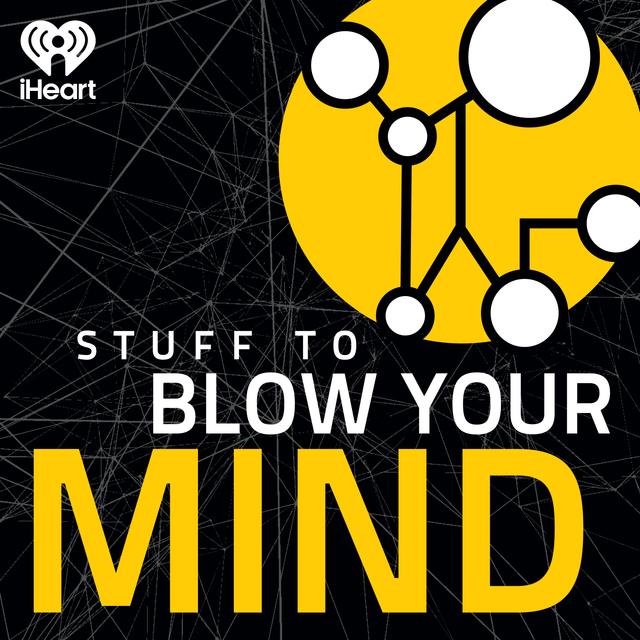Welcome to Stuff to Blow Your Mind, a production of iHeartRadio.
Hi, my name is Robert Lambin. This is the Monster Fact, a short form series from Stuff to Blow Your Mind, focusing in non mythical creatures, ideas and monsters in time. In this episode, I like to discuss one of the classic monster icons of twentieth century horror cinema, the Undead Mummy.
You've all encountered some variation on this monster before, if not in the original six part Universal Pictures Mummy franchised, then perhaps in nineteen eighty seven's The Monster Squad or nineteen nineties Tales from the Dark Side, the movie which has a very memorable adaptation of Sir Arthur Conan Doyle's Lot two forty nine, which I'll touch on again in
a bit. For my own part, I fondly remember reading a pair of kids books from the late eighties and nineties when I was a child, by Alita E. Young, Terror in the Tomb of Death and Returned to the Tomb of Death, both of which featured undead mummies and ancient Egyptian curses. Now, to properly understand mummy horror fiction in general, we have to recognize its place within the
larger world of Egyptomania. The term Egyptomania is more often used to refer specifically to nineteenth century European fascination with all things Egypt in the wake of Napoleon's Egyptian campaign, but it can also generally be leveled at different points in time when various cultures have pursued an interest in
ancient Egyptian civilization and culture. In the excellent book Egyptomania, author Ronald H. Fritz discusses various forms of Egyptomania over the ages, from the ancient Hebrews, Greeks, and Romans to Europeans and afrocentrist movements. He also devotes a chapter to
Hollywood movies and literature. He writes that Egyptian themed fiction in its current forms emerged during the nineteenth century, again after Napoleon's campaign in Egypt inspired a new surge in European Egyptomania, surplanting Egypt's smaller place in the European culture of the time period, where it was mostly relegated to its role in Shakespearean theater, freemasonry, and sporadic fictional treatments. Fritz writes that Egyptian themed fiction basically falls into a
number of subgenres. There's historical fiction, biblical fiction, mysteries and thrillers, occult fiction, and yes, there is the mummy fiction. But where does the idea of undead mummified ancient Egyptians come from in all of this? Well, the nineteen thirty two universal horror movie The Mummy might seem like a good place to start, after all, it kicked off a rather influential franchise, but Fritz shares that early versions of the script didn't feature an undead mummy at all. This settlement
was only added later in subsequent rewrites. Unlike Dracula and Frankenstein, the Mummy frame was not rooted in a particular work of literature, Though there are clear literary forbears, nineteen thirty two is The Mummy wasn't even the first mummy motion picture. Consider instead that the likes of nineteen eleven's The Mummy, in which a scientist revives an Egyptian mummy with electricity and then falls in love with her sadly lost, is just one of a flurry of silent mummy movies from
the nineteen tens. As for literary sources, Sir Arthur Conan Doyle's short stories The Ring of Thoth eighteen ninety and Lot Number two forty nine eighteen ninety two are important to note, as is Brahm Stoker's The Jewel of the Seven Stars from nineteen oh three. Fritz singles out The Mummy or a Tale of the twenty second Century by Jane C. Loudon from eighteen twenty seven as the earliest
long work concerning a reanimated mummy. Other early examples of reanimated mummy story include Theophile Gottner's The Mummy's Foot and Edgar Allen Poe's eighteen forty five story Some Words with a Mummy. These stories, according to Fritz, arise in general again out of nineteenth century Egyptomania, but also out of European and American fascination with mummies and mummy unwrapping parties.
In particular. He also writes that we can't underestimate Victorian colonial guilt and misgivings about the desecration of Egyptian tombs and artifacts as a strong motivation for summoning so many tales in which over eager American and European archaeologists on Earth ancient tombs ancient curses and invoked the wrath of
the untead. In fact, he points out that initially mummy stories cast archaeologists firmly in the role of villains, but then the needle moved in the opposite direction quote after the discovery of Tutenkammen's tomb nineteen twenty two. Thanks to the film industry, archaeologists were portrayed as heroic, scholarly adventures, while angry mummies were not avengers but the revived, corporeal forms of a mindless ancient evil. This shift is in
effect an affirmation or vindication of imperialism and colonialism. On top of all of this, there's, of course the influence of pre existing tales of cursed objects and the unsettled dead, which would have found new life in Egyptomania fuel creations. These various elements all would seem to have contributed to the undead mummy's place in our horror fiction. Tune in for additional episodes of The Monster Fact or The Artifact
each week. As always, you can email us at contact at stuff to Blow your Mind dot com.
Stuff to Blow Your Mind is production of iHeartRadio. For more podcasts from My Heart radio, visit the iHeartRadio app, Apple podcasts, or wherever you listen to your favorite shows.
